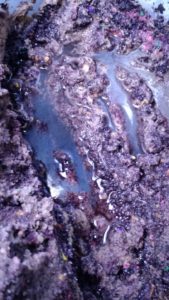 A couple years ago when we created our Facebook group to go along with our website I was shocked to find so many people with flooding issues and bacterial blooms in their crabitats. The response to this was a false bottoms. In 14 years of crab keeping I’ve never encountered this, so it’s on my mind all the time…where is all the water coming from?
A couple years ago when we created our Facebook group to go along with our website I was shocked to find so many people with flooding issues and bacterial blooms in their crabitats. The response to this was a false bottoms. In 14 years of crab keeping I’ve never encountered this, so it’s on my mind all the time…where is all the water coming from?
I think I may be on the path to the root cause – overly wet substrate at the beginning.
When you take sandcastle wet sand, add wet ecoearth, add bubbler pools and heat and it’s no wonder the humidity in tank skyrockets and stays there. And it’s no wonder the tank floods, all that excess water has to go somewhere after the substrate becomes completely saturated.
When temperatures fluctuate outside of the tank, condensation can occur. Condensation in the tank is going to end up in the substrate, wetting the ecoearth even more. Eco earth gets warm when it’s wet, have you noticed that? Hot, soggy tank = disaster.
Prior to my house fire I had my 150 set up and had switched from exclusively using overheat lights to using lights with heat pads. I also put in larger pools and one with a filter, in a segmented section of my tank with Growstone around it. This was to monitor for pool leaks but that never occurred.
Before long I could tell my substrate was getting wetter. Algae was beginning to grow on my cork wall divider a few inches below the surface. My humidity was in range but that was likely because I was still using my overhead light hoods at the time and they burn off a lot of humidity.
After the fire I set up my 150 with dry sand. It wasn’t dusty dry but it was pretty close. I chose to use only one thin layer of dry ecoearth and instead added in some coarse chunks of coconut shell. Eco earth was originally added to help the sand retain moisture, now it may be overkill. This decision was based on @Lisa Dawson ’s flood which was trigger by extreme Australian heat causing her tank to overheat and sweat, then the ecoearth got warm and she ended up with a nightmare in her beautiful crabitat. My tank has two LARGE filtered, waterfall pools.
In the photo below you can see how the moisture is creeping down through the layers of sand. I’m sure the sand around the pools is wetter from splashing and minor spills during cleaning.
The tank has been set up about three months now and successful molts are occurring. My humidity is stable, not climbing over 80% unless we have an unusually warm winter day. I will try to take additional photos in the coming months. I don’t know how long it will take the sand to get saturated at the current rate, hopefully never if my humidity stays controlled. After bringing the lights inside the tank my humidity has dropped to the lower end of the safe range at times. I am thinking of bringing the pools up higher when everyone is above ground so that I can add more sand (miscalculation at set up). I will use dry sand again and that should give me some additional information to work with.
So I’m presenting my suggestions for modifications in our instructions for setting up the substrate for further discussion. Those suggestions are as follows.
When setting up your tank don’t add water to the sand. My sand felt dry but in reality had enough moisture to pack right out of the bag. Wet sand should be dried before adding to the tank. Mix up your ecoearth far enough in advance to allow it to dry out completely before mixing into your sand. If you are installing bubbler or filtered pools I don’t think you will ever have to wet the sand. If your humidity comes up to the safe range after a few stays, the sand will absorb moisture from the air.
If you are using standard pools (deep enough but no bubbler/filter) you might have to lightly mist the top layer of sand to get things going.
CSJ has also officially changed it’s stance on mixing moss INTO your substrate, read more about that.
Note: crossposted on The Crabstreet Journal as well as our Facebook group to encourage discussion.
These ads are automatically served by Amazon. Not all products marketed for hermit crabs are actually safe for hermit crabs. Do your research!







